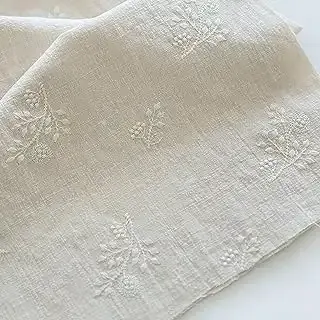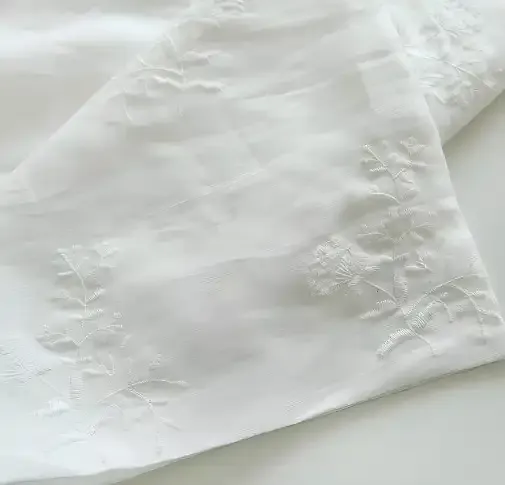Introduction
Japanese fabric has a rich cultural heritage and has captivated people worldwide with its intricate craftsmanship and timeless beauty. From traditional textile techniques dating back centuries to contemporary applications in fashion and design, Japanese fabric continues to inspire and awe. This article delves into the fascinating world of Japanese fabric, exploring its history, popular types, cultural significance, and current trends. We will also delve into sustainability and ethical considerations in fabric production and provide insights into Japanese fabric markets. Join us on this journey as we unravel the allure and significance of Japanese fabric in the global textile industry.
The Rich History of Japanese Fabric
When it comes to fabric, Japan has a story to tell. With a history dating back centuries, Japanese fabric carries the legacy of ancient traditions and craftsmanship. Each piece of fabric tells a unique tale, from intricate prints to delicate weaves.
Influence of Japanese Culture on Fabric
Japanese culture has influenced fabric in ways that go beyond mere aesthetics. The emphasis on simplicity, harmony, and nature in Japanese culture can be seen in the designs and motifs found in traditional Japanese fabrics. The calmness of Zen gardens and the grace of Kabuki performances are beautifully captured in the fabric, making it a true reflection of Japanese art and culture.
Traditional Japanese Textile Techniques
i. Shibori: The Art of Japanese Tie-Dye
Shibori is the superstar of Japanese textile techniques. Artisans create stunning patterns in fabric using various methods such as folding, twisting, and binding. The result is a textile masterpiece showcasing the unique irregularities and organic beauty of hand-dyed fabric.
ii. Katagami: Japanese Stencil Dyeing
Katagami is a traditional Japanese technique that involves creating intricate stencils. These stencils apply dye onto the fabric, producing mesmerizing designs. The precision and detail achieved through this technique are awe-inspiring, making each piece of fabric a work of art.
iii. Yuzen: The Intricate Art of Japanese Kimono Printing
Yuzen is the art of hand-painting intricate designs on silk. This technique is primarily used for creating exquisite kimono fabrics. From vibrant florals to intricate landscapes, Yuzen printing brings Japan's rich cultural heritage to life in every brush stroke.
Popular Types of Japanese Fabrics
i. Silk: The Quintessential Japanese Fabric
Silk, the epitome of luxury, has a special place in Japanese fabric culture. From kimono to obi, silk fabrics are prized for their lustrous sheen and smooth texture. The beauty of silk lies not only in its appearance but also in the way it drapes and moves, making it a symbol of elegance and refinement.
ii. Cotton: Versatile and Comfortable
Cotton, the go-to fabric for everyday wear, holds a special place in Japanese fashion. Known for its breathability and softness, cotton fabrics create comfortable garments for any occasion. From casual yukata to stylish everyday wear, cotton fabrics are a staple in Japanese fashion.
iii. Hemp: The Eco-Friendly Choice
Hemp fabric, known for its durability and sustainability, has gained popularity recently. Its natural resistance to pests and minimal environmental impact make it an eco-conscious choice. Whether used for clothing or home textiles, hemp fabric carries the spirit of sustainable living in every thread.
iv. Wool: Warmth and Luxury
When winter arrives, wool becomes the fabric of choice in Japan. With its exceptional insulation properties and softness, wool keeps you cozy in the chilly months. From warm winter coats to cozy blankets, wool fabrics add a touch of luxury to both fashion and home decor.
Significance of Japanese Fabric in Cultural Context
i. Kimono: The Iconic Japanese Garment
The kimono, a traditional Japanese garment, showcases the beauty and versatility of Japanese fabric. From weddings to tea ceremonies, kimonos hold deep cultural significance and are often passed down through generations. The intricate fabrics used in kimono-making reflect Japan's rich history and traditions.
ii. Obi: Symbolism and Functionality
The obi, a wide sash worn with the kimono, adds elegance and tells a story. Obis often feature symbolic motifs and designs that convey messages of good fortune, prosperity, or even the changing seasons. The obi is not just a fashion accessory but an essential element in Japanese culture and fashion.
iii. Traditional Festivals and Ceremonies
Japanese fabric plays a crucial role in traditional festivals and ceremonies. Whether it's the vibrant yukata worn during summer festivals or the beautiful noren curtains adorning entrances during special occasions, fabric brings color and life to these cultural celebrations. It is through fabric that the essence of Japanese culture is vividly displayed and celebrated.
Japanese fabric is more than just cloth; it is a testament to Japan's artistry, history, and culture. From traditional techniques to popular fabrics, each thread weaves a story that honors the past while embracing the present. So, next time you admire a piece of Japanese fabric, remember that you're holding a piece of history and culture.
Contemporary Applications of Japanese Fabric
i. Fashion and Apparel Industry
Regarding fashion, Japanese fabric has captured the attention of designers and fashion enthusiasts worldwide. From luxurious silk kimonos to trendy denim, Japanese textiles offer a wide range of options for creating unique and stylish garments. The impeccable craftsmanship and attention to detail make Japanese fabrics highly sought after in the fashion industry.
ii. Interior Design and Home Furnishings
Japanese fabric is not limited to fashion; it has also made its mark in interior design and home furnishings. With their exquisite patterns and textures, fabrics like traditional indigo-dyed textiles and intricately woven silk are perfect for adding a touch of elegance and authenticity to any space. Japanese fabrics can be used for curtains, upholstery, pillow covers, and wall hangings, breathing new life into homes worldwide.
iii. Art and Craft Revival
Japanese fabric has sparked a revival in the world of art and craft. Artists and crafters are drawn to the unique qualities of Japanese textiles, using them as a medium for creating stunning pieces of art. Whether using vintage kimono fabric in mixed-media collages or incorporating traditional weaving techniques into contemporary sculptures, Japanese fabric has inspired many artists seeking to blend tradition with modernity.
Sustainability and Ethical Considerations in Japanese Fabric Production
i. Traditional Methods and Sustainable Practices
Japanese fabric production has a deep-rooted connection to sustainable practices. Many traditional methods, such as natural dyeing with plant-based materials and organic fibers, prioritize environmental friendliness. These practices not only help preserve the planet but also contribute to Japanese fabrics' unique characteristics and longevity.
ii. Fair Trade and Ethical Sourcing
Fairtrade and ethical sourcing have become increasingly crucial in fabric production. Japanese fabric manufacturers, recognizing this demand, have embraced fair trade practices by ensuring fair wages and safe working conditions for their workers. Additionally, many companies prioritize sourcing materials from local artisans and small-scale producers, supporting the preservation of traditional craftsmanship.
iii. Preservation of Traditional Techniques
Preserving traditional fabric production techniques is a crucial aspect of ensuring the sustainability of Japanese textiles. In recognition, efforts are being made to pass down these techniques to younger generations through apprenticeships and educational programs. By safeguarding these skills, the Japanese fabric industry maintains its rich heritage and paves the way for a sustainable future.
Exploring Japanese Fabric Markets and Trends
i. Local Markets and Specialized Stores
Exploring local markets and specialized stores is an excellent way to immerse yourself in the world of Japanese fabric. From bustling markets in Tokyo to quaint shops in Kyoto, these places offer a wide range of fabrics, from traditional to contemporary designs. Here, you can find unique textile treasures and interact with knowledgeable vendors who can guide you through Japanese fabrics' different types and qualities.
ii. Online Platforms and Global Accessibility
With the rise of e-commerce, Japanese fabric is now more accessible than ever. Numerous online platforms offer a vast selection of fabrics, allowing people worldwide to explore and purchase Japanese textiles with just a few clicks. This global accessibility has expanded the Japanese fabric market and contributed to the exchange of ideas and inspiration among designers and creators worldwide.
iii. Emerging Trends in Japanese Fabric Design
Japanese fabric design constantly evolves, with new trends emerging in response to changing consumer preferences and global influences. From contemporary reinterpretations of traditional motifs to experimental textile techniques, the world of Japanese fabric design continues to push boundaries. Keep an eye out for innovative collaborations, unique prints, and unconventional fabric combinations in the ever-evolving landscape of Japanese textiles.
Future Perspectives on Japanese Fabric
Japanese fabric is a true testament to the timeless beauty of craftsmanship and the art of textile production. Its versatility and cultural significance have captured people's hearts from all walks of life. As sustainability and ethical considerations gain more importance in the industry, Japanese fabric is well-positioned to thrive, thanks to its traditional methods, fair trade practices, and commitment to preserving heritage techniques. With increasing accessibility through local markets, specialized stores, and online platforms, the future of Japanese fabric looks promising, offering endless opportunities for creativity and inspiration. So, whether you're a fashion lover, an interior design enthusiast, or an artist seeking to explore new possibilities, Japanese fabric will captivate your imagination and leave a lasting impression.
Conclusion
Japanese fabric is a testament to the country's rich cultural heritage and artistic craftsmanship. From the traditional techniques of shibori and katagami to the contemporary applications in fashion and home decor, Japanese fabric continues to inspire and captivate. As we move forward, we must prioritize sustainability and ethical practices in fabric production to preserve these timeless traditions. With increasing global recognition and demand, Japanese fabric markets are thriving, offering a treasure trove of unique, high-quality textiles. The future of Japanese fabric holds exciting possibilities as designers and artisans continue to innovate and push the boundaries of this extraordinary art form. Let us appreciate and celebrate the beauty of Japanese fabric, a true testament to the enduring spirit of creativity and craftsmanship.
Some Special Questions
1. What are some popular types of Japanese fabrics?
Japanese fabrics are diverse and renowned for their quality and uniqueness. Some popular types include silk, cotton, hemp, and wool. Each fabric has distinct characteristics and is used in various traditional and contemporary applications.
2. How can I incorporate Japanese fabric into my home decor?
Japanese fabric can bring a touch of elegance and authenticity to your home decor. Consider using it for curtains, throw pillows, table runners, or even framed as wall art. Japanese fabric's intricate patterns and vibrant colors can instantly transform a space and create a tranquil and refined atmosphere.
3. Are there sustainable and ethically produced Japanese fabrics available?
Yes, there are sustainable and ethically produced Japanese fabrics available. Many artisans and manufacturers in Japan prioritize eco-friendly practices, using natural dyes, organic materials, and traditional production methods with minimal environmental impact. Look for certified fair trade and sustainable labels when purchasing Japanese fabric to support ethical production.
4. Where can I find authentic Japanese fabrics?
Authentic Japanese fabrics can be found in various places. Local markets, specialized stores, and online platforms dedicated to Japanese textiles are great places to start. Additionally, visiting Japan offers the opportunity to explore a wide range of fabric markets and traditional craft centers, where you can find a vast selection of authentic Japanese fabrics directly from the source.











0 Comments